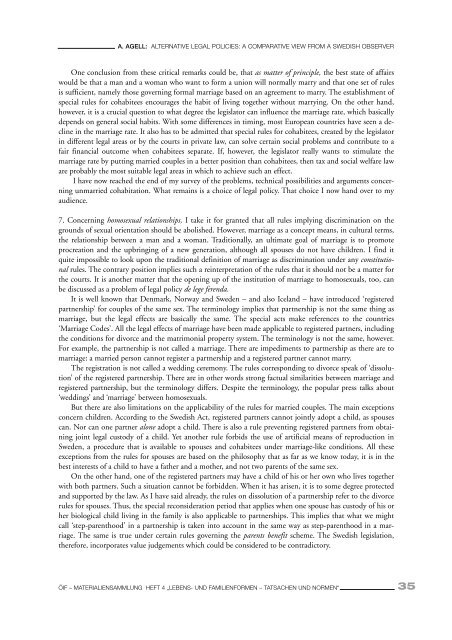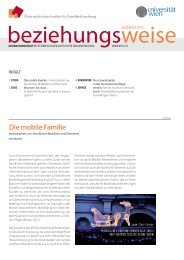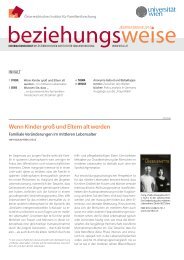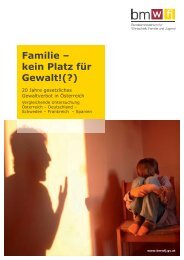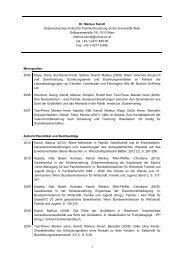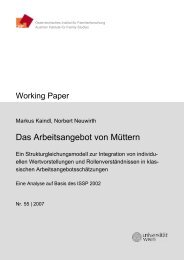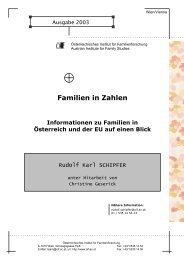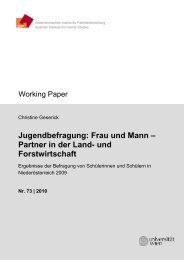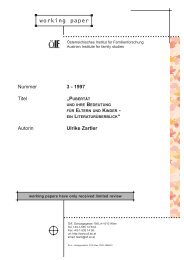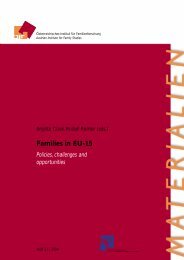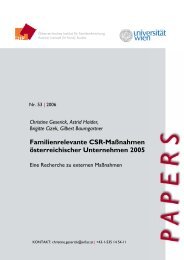Lebens- und Familienformen - Tatsachen und Normen
Lebens- und Familienformen - Tatsachen und Normen
Lebens- und Familienformen - Tatsachen und Normen
Erfolgreiche ePaper selbst erstellen
Machen Sie aus Ihren PDF Publikationen ein blätterbares Flipbook mit unserer einzigartigen Google optimierten e-Paper Software.
A. AGELL: ALTERNATIVE LEGAL POLICIES: A COMPARATIVE VIEW FROM A SWEDISH OBSERVER<br />
One conclusion from these critical remarks could be, that as matter of principle, the best state of affairs<br />
would be that a man and a woman who want to form a union will normally marry and that one set of rules<br />
is sufficient, namely those governing formal marriage based on an agreement to marry. The establishment of<br />
special rules for cohabitees encourages the habit of living together without marrying. On the other hand,<br />
however, it is a crucial question to what degree the legislator can influence the marriage rate, which basically<br />
depends on general social habits. With some differences in timing, most European countries have seen a decline<br />
in the marriage rate. It also has to be admitted that special rules for cohabitees, created by the legislator<br />
in different legal areas or by the courts in private law, can solve certain social problems and contribute to a<br />
fair financial outcome when cohabitees separate. If, however, the legislator really wants to stimulate the<br />
marriage rate by putting married couples in a better position than cohabitees, then tax and social welfare law<br />
are probably the most suitable legal areas in which to achieve such an effect.<br />
I have now reached the end of my survey of the problems, technical possibilities and arguments concerning<br />
unmarried cohabitation. What remains is a choice of legal policy. That choice I now hand over to my<br />
audience.<br />
7. Concerning homosexual relationships, I take it for granted that all rules implying discrimination on the<br />
gro<strong>und</strong>s of sexual orientation should be abolished. However, marriage as a concept means, in cultural terms,<br />
the relationship between a man and a woman. Traditionally, an ultimate goal of marriage is to promote<br />
procreation and the upbringing of a new generation, although all spouses do not have children. I find it<br />
quite impossible to look upon the traditional definition of marriage as discrimination <strong>und</strong>er any constitutional<br />
rules. The contrary position implies such a reinterpretation of the rules that it should not be a matter for<br />
the courts. It is another matter that the opening up of the institution of marriage to homosexuals, too, can<br />
be discussed as a problem of legal policy de lege ferenda.<br />
It is well known that Denmark, Norway and Sweden – and also Iceland – have introduced ‘registered<br />
partnership’ for couples of the same sex. The terminology implies that partnership is not the same thing as<br />
marriage, but the legal effects are basically the same. The special acts make references to the countries<br />
‘Marriage Codes’. All the legal effects of marriage have been made applicable to registered partners, including<br />
the conditions for divorce and the matrimonial property system. The terminology is not the same, however.<br />
For example, the partnership is not called a marriage. There are impediments to partnership as there are to<br />
marriage: a married person cannot register a partnership and a registered partner cannot marry.<br />
The registration is not called a wedding ceremony. The rules corresponding to divorce speak of ‘dissolution’<br />
of the registered partnership. There are in other words strong factual similarities between marriage and<br />
registered partnership, but the terminology differs. Despite the terminology, the popular press talks about<br />
‘weddings’ and ‘marriage’ between homosexuals.<br />
But there are also limitations on the applicability of the rules for married couples. The main exceptions<br />
concern children. According to the Swedish Act, registered partners cannot jointly adopt a child, as spouses<br />
can. Nor can one partner alone adopt a child. There is also a rule preventing registered partners from obtaining<br />
joint legal custody of a child. Yet another rule forbids the use of artificial means of reproduction in<br />
Sweden, a procedure that is available to spouses and cohabitees <strong>und</strong>er marriage-like conditions. All these<br />
exceptions from the rules for spouses are based on the philosophy that as far as we know today, it is in the<br />
best interests of a child to have a father and a mother, and not two parents of the same sex.<br />
On the other hand, one of the registered partners may have a child of his or her own who lives together<br />
with both partners. Such a situation cannot be forbidden. When it has arisen, it is to some degree protected<br />
and supported by the law. As I have said already, the rules on dissolution of a partnership refer to the divorce<br />
rules for spouses. Thus, the special reconsideration period that applies when one spouse has custody of his or<br />
her biological child living in the family is also applicable to partnerships. This implies that what we might<br />
call ‘step-parenthood’ in a partnership is taken into account in the same way as step-parenthood in a marriage.<br />
The same is true <strong>und</strong>er certain rules governing the parents benefit scheme. The Swedish legislation,<br />
therefore, incorporates value judgements which could be considered to be contradictory.<br />
ÖIF – MATERIALIENSAMMLUNG HEFT 4 „LEBENS- UND FAMILIENFORMEN – TATSACHEN UND NORMEN“ 35


